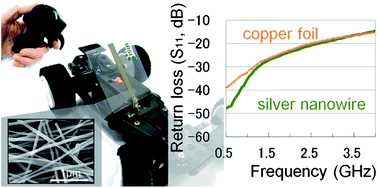Printed silver nanowire antennas with low signal loss at high-frequency radio†
Abstract
Silver

* Corresponding authors
a
The Institute of Scientific and Industrial Research, Osaka University, Mihogaoka 8-1, Ibaraki, Osaka, Japan
E-mail:
nogi@eco.sanken.osaka-u.ac.jp
Fax: +81-6-6879-8522
Tel: +81-6-6879-8521
b Department of Adaptive Machine systems, Graduate school of Engineering, Osaka University, Yamadaoka 2-1, Suita, Osaka, Japan
c Collaborative Research Centre, Meisei University, Hodokubo 2-1-1, Hino, Tokyo, Japan
Silver

 Please wait while we load your content...
Something went wrong. Try again?
Please wait while we load your content...
Something went wrong. Try again?
N. Komoda, M. Nogi, K. Suganuma, K. Kohno, Y. Akiyama and K. Otsuka, Nanoscale, 2012, 4, 3148 DOI: 10.1039/C2NR30485F
To request permission to reproduce material from this article, please go to the Copyright Clearance Center request page.
If you are an author contributing to an RSC publication, you do not need to request permission provided correct acknowledgement is given.
If you are the author of this article, you do not need to request permission to reproduce figures and diagrams provided correct acknowledgement is given. If you want to reproduce the whole article in a third-party publication (excluding your thesis/dissertation for which permission is not required) please go to the Copyright Clearance Center request page.
Read more about how to correctly acknowledge RSC content.
 Fetching data from CrossRef.
Fetching data from CrossRef.
This may take some time to load.
Loading related content
